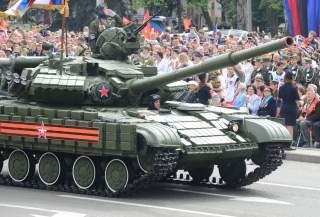T-64: Russia's Elite Cold War Super Tank?
The T-64 sported many firsts for the Soviet Union — the first tank with composite armor, first tank with an autoloader, first tank with a smoothbore gun. It was innovative, but expensive, and mechanically complex.
The T-64 sported many firsts for the Soviet Union — the first tank with composite armor, first tank with an autoloader, first tank with a smoothbore gun. It was innovative, but expensive, and mechanically complex.
Despite the technological leaps that were made with the T-64 platform, it was doomed by it’s price and never exported outside of the Soviet Union, stationed initially in East Germany, poised to defend against a potential attack by NATO.
Not Your Mom’s Ceramics Class
The T-64 was intended to fit the armor protection and firepower of a heavy tank onto a medium platform. This would, in theory, allow the tank to remain relatively nimble, despite the increase in firepower.
In order to achieve an adequate level of protection, a type of composite armor was fitted onto the T-64. This armor was essentially a layer of glass-reinforced plastic that was sandwiched in between two layers of ceramic, that were in turn sandwiched in between two layers of steel. More lightweight than a single, equally thick layer of steel, and significantly lighter. Armor — check.
Firepower > Space
In order to fit the additional firepower into a medium tank-sized package, an autoloader was designed into the turret, reducing the crew by one, from four to a total of just three. One less body, plus a new, more compact engine design, kept the T-64 profile relatively small.
While innovative and extremely compact, the new engine design was plagued by reliability issues. It had achieved its purpose — a compact design — at a steep reliability cost, and an increased production cost.
Before mass production, T-64 prototypes experimented with a 115-millimeter gun, a 10-millimeter upgrade from it’s predecessor, the T54/55 series. Ultimately though, Soviet engineers went in a different direction and settled on a 125-millimeter smoothbore gun. This allowed the tank to fire anti-tank guided missiles.
While the 125-millimeter gun was a marked increase in firepower, the longer and larger diameter rounds took up more internal storage space than the 100- or 115-millimeter rounds had. Combined with the emphasis on maintaining the lower profile of a medium tank, there was less internal storage capacity available for main-gun ammunition, reducing the number of rounds available to the gunner and tank.
Ukrainian T-64BM Bulat
Despite the aforementioned drawbacks, the T-64 platform is still used as a front-line tank, albeit with significant upgrades. In Ukraine, the heavily modified T-64BM Bulat has been outfitted with a number of upgrades, including explosive reactive armor (ERA) and an upgraded fire control system, and giving them a new lease on life.
According to the website of the company responsible for upgrading Ukraine’s T-64s to the Bulat standard, their work protects against “antitank hand grenades, and projectiles fired from hand-held and heavy grenade launchers and recoilless guns, against anti-tank guided missiles such as TOW-2, Milan, and Shturm-S, against shaped-charge projectiles fired from 125-mm smoothbore tank guns (ZBK-14(14M), ZBK-18), and against armor-piercing fin-stabilized discarding sabot projectiles fired from 125 mm smoothbore tank guns (ZBM-22, ZBM-26, ZBM-42.”
If true, then Ukraine’s T-64s may have some bike left in their bark.
Caleb Larson is a Defense Writer with The National Interest. He holds a Master of Public Policy and covers U.S. and Russian security, European defense issues, and German politics and culture.

